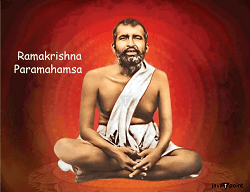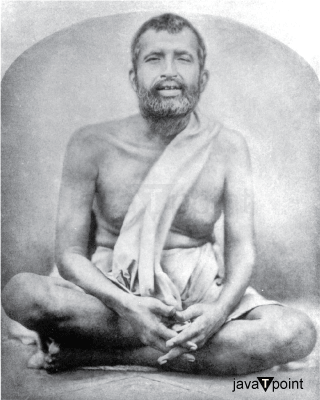Ramakrishna Paramahamsa
Ramakrishna Paramahamsa was born on February 18, 1836, in the Hoogly District of the Bengal Presidency, in the village of Kamarpukur. His parents' names were Chandramani Devi and Khudiram Chattopadhyay. Name of the wife of Sri Ramakrishna Paramahamsa, Saradamoni Devi. Ramakrishna Paramahamsa's philosophical beliefs include Shakto, Advaita Vedanta, universal tolerance, and his religious views on Hinduism and Advaita. Ramakrishna Paramahamsa passed away on August 16, 1886, in Cossipore, Kolkata. His memorial is located in the Dakshineshwar Kali Temple Compound in Kolkata, West Bengal, as well as in his hometown of Kamarpukur Village in the Hoogly District. About Ramakrishna ParamahamsaRamakrishna was born into a humble Bengali family in 1836. He is one of India's most famous religious leaders of the nineteenth century. He is known as a mystic and a yogi because of his ability to elucidate complex spiritual concepts. He was an honest and simple yogi. Throughout his life, he sought the divine in many forms. He believed that everyone is the divine manifestation of the supreme being. Although he is sometimes seen as the modern-day incarnate of lord Vishnu, he personified spiritual salvation for people suffering from various afflictions. He played a crucial role in the revival of Hinduism in Bengal when the nation was amid a spiritual crisis that saw the vast majority of young Hindus convert to Muslims and Christianity. Despite his untimely death in 1886, his most famous student, Swami Vivekanand, continued to disseminate his teachings and ideas worldwide through the Mission of Ramakrishna. At its core, his teachings are as traditional as the wise people and seers of ancient times, but he has always remained modern. The Early YearsGadadhar was born on February 18, 1836, in the village of Kamarpukur, Hoogly district, in the Indian state of Bengal. He was the only child of a poor Brahmin family. His mother name was Chandramani Devi, and he was named Ramakrishna. At a young age, Gadadhar went to the village school to study Sanskrit. However, as a rebellious child, he often skipped classes. 
He loved to draw and shape clay into the shapes of Hindu gods and goddesses. He was mesmerized by folktales and legends told to him by his mother. With the help of priests and other sages, he could learn the Ramayana and Mahabharata, as well as the Puranas and other holy books, by heart. Gadadhar spent much time working in orchards or along rivers when he was younger because he loved being in the natural world. From a young age, Gadadhar had a strong religious faith and would experience spiritual blessings from everyday things. He'd go into a trance while performing prayers or watching religious plays. After Gadadhar's father died in 1843, his elder brother Ramkumar assumed responsibility for the family. Ramkumar moved to Calcutta to make money for the family, so Gadadhar returned to his village and started worshipping the family god, which his brother used to do. He would do the pujas hard because he was religious. Meanwhile, Ramkumar had started a Sanskrit school in Kolkata and was a priest at some socio-religious functions. Ramakrishna got married in 1859 when he was just 23 years old. Saradamuni was five years old and came from a village near here. The couple stayed apart until she grew up, and by the time she was 18, she came to live with him in Dakshineswar. He said she was a manifestation of the Divine Mother and that she came to him on the throne of Goddess Kali during the shodashi puja. She supported his ideas greatly and made it easy for him to take care of his students. Arrival in Dakshineshwar and Priestly InductionThe Kali temple was founded in 1855 by the famous philanthropist and queen of Janbazaar, Rinu Rashmoni. She had difficulty finding a priest since her family was from Kaibarta, considered a lower caste in Bengali society at the time. So, she asked Ramkumar, her son-in-law, to come to Calcutta. He was asked to become the temple's chief priest, and Ramkumar said yes. He asked Gadadhar to come to him and help him with his daily rituals, and when Gadadhar arrived, Ramkumar got the job of decorating the God. Ramakrishna took over as the head priest of the temple after Ramkumar died in 1856. This was when Gadadhar started his long and storied journey to the priesthood. It's said that after seeing how devout he was and some strange things that happened to him, Mathurabu called him "Ramakrishna." Religious ExperienceHe was classified as a "Shakto" because he was a devotee of the goddess Kali. However, this did not stop him from pursuing other spiritual paths. He is believed to be one of the rare yogis who studied under different Gurus and absorbed their philosophical teachings to become a true believer in God. He worships God Rama like Hanuman, the most loyal of Rama's followers. Between 1861 and 1863, Ramakrishna was guided by a woman called Bhairavi Brahma, who taught him the subtleties of Tantric practices. She guided him to complete all 64 of them, including the most difficult ones. Bhairavi also taught him Yoga called Kundalini. Ramakrishna went on to learn more about the deeper meaning of Vaishnavism, which had a way of seeing the world and practices different from Shakttha's Tantric methods. In 1864 he was taught by Guru Jatadasari. He was a devotee of God, especially Lord Vishnu, in the shape of a baby and with the look of a mother, and he was also a devotee of Vishnu's son Radha. He had a vision in Nadia, where he merged with his body. Ramakrishna started his spiritual journey in 1865 when monk Totapuri brought him into the official monk life called Sanyaas, where Totapuri guided him through the rituals of renunciation. Totapuri taught him the teachings of the Advaita school of Hinduism, which emphasized the importance of Brahma and the unity of spirit. Around this time, he reached the peak of his spiritual growth. Ramakrishna then devoted himself to Islam, devoutly performing all the faith rituals. He even had visions of a beautiful, white-haired figure. But it wasn't until 1873, when a follower read him the Bible, that he got into Christ's teachings. He saw Jesus, the Madonna, and the Child in a vision. Teachings and Social InfluenceHe was an honest person who, at times with childlike excitement, used the most simple parables, tales, and anecdotes to illustrate even the most difficult spiritual topics. His remarks came naturally from a strong faith in God and his experience of embracing God in a very concrete way. He stipulated that God-realization should be the ultimate objective of every living soul. Having been involved in many aspects of Hinduism and other religions like Islam and Christianity, he proclaimed that all of these ways ultimately led to the same destination?God. Mahendranath Gupta, one of his followers, documented his talks with his followers and compiled them into a text he called Sri Sri Ramakrishna Kathamrita (The Nectar of Sri Ramakrishna's Words). To remove the notion that he belonged to a superior Brahmanical caste, he began consuming meals made by the Shudras, or inferior caste. He did not distinguish between followers based on caste, and his influence spread across every strata of society. He even won over the skeptic with his straightforward charm and selfless affection. He served as an inspiration for renewal in Bengal in the nineteenth century, reviving the dying Hinduism. His ideas also significantly impacted other religions, such as Brahmoism, which was compelled to reexamine its principles. Important FollowersSwami Vivekananda was one of the most well-known of his many followers, and he was a key figure in spreading his philosophy to the rest of the world. In 1897, he started the Mission to help spread the message of his guru Ramakrishna. In addition to Vivekananda, his followers Kaliprasad Chandra (Swami Abhedananda), Sashibhushan Chakravarty (Swami Ramakrishnananda), Rakhal Chandra Ghosh (Swami Brahmananda), Sarat Chandra Chakravarty (Swami Saradananda) all gave of their family life and joined him in founding Ramakrishna Mat. All of them played a big part in helping him spread his message of Seva and his teachings worldwide, not just in India. Ramakrishna significantly influenced Sri Keshab Chandra Sen, a prominent Brahmo Samaj leader, and his direct students. Keshab Chandra Sen was persuaded to drop the rigidity of Brahmo's beliefs by Ramakrishna's teachings and companionship. He acknowledged polytheism and announced the Brahmo order's Naba Bidhan movement. He spread Ramakrishna's teachings through his Naba Bidhan publications and was essential in making the mystic prominent among the upper classes of modern Bengali society. Mahendranath Gupta, a devotee who stuck with Ramakrishna despite having a family; Girish Chandra Ghosh, a renowned poet, playwright, theatre director, and actor; Mahendra Lal Sarkar, one of the most prominent homeopaths of the nineteenth century and saint and mystic Akshay Kumar Sen were among Ramakrishna's other notable disciples. Ramakrishnan Passes AwayRamakrishnan was diagnosed with throat cancer in the year 1885. His followers moved him to the home of a devotee in Shyampukur so that he could get medical advice from the best doctors in Kolkata. Over the years, Ramakrishnan's health deteriorated, and he was taken to a big house in Chossipore. He died in the garden of Cossipore on August 16, 1886, due to his deteriorating health. Ramakrishnan memorial is located in the Dakshineshwar Kali Temple Compound in Kolkata, West Bengal, as well as in his hometown of Kamarpukur Village in the Hoogly District. ConclusionRamakrishna Paramahamsa, a prominent Indian religious leader, was born in 1836 in Hoogly District, Bengal Presidency. A mystic and yogi, he studied Sanskrit and was fascinated by folktales and legends. Born into a poor Brahmin family, he played a crucial role in the revival of Hinduism in Bengal. Despite his untimely death in 1886, his student Swami Vivekanand continued to disseminate his teachings worldwide through the Mission of Ramakrishna. FAQ on Ramakrishna ParamahamsaQuestion 1: Describe Ramakrishna Paramahamsa in a few words.Answer: The Ramakrishna Order of Monks was established by the 19th-century saint Ramakrishna Paramahamsa (1836-1886), who was also considered the movement's spiritual leader. His most important student was Swami Vivekananda (1863-1902). Question 2: Did Ramakrishna face Kali?Answer: It is stated in Ramakrishna Kathmrita (also known as "The Gospel of Ramakrishna") that Ramakrishna saw Kali from many perspectives and even desired to worship her by going to a church. Question 3: How does the Ramakrishna Mission provide mantra diksha?Answer: The President and Vice President of the Ramakrishna Order continue providing Mantra Deeksha to aspirant spirits. After inspection, the Sri Ramakrishna Math in Kanchipuram also arranges Mantra Deeksha for potential devotees.
Next TopicSyed Sehrish Asgar
|
 For Videos Join Our Youtube Channel: Join Now
For Videos Join Our Youtube Channel: Join Now
Feedback
- Send your Feedback to [email protected]
Help Others, Please Share









